IFN-gamma protein levels at MPA onset may predict relapses
Findings suggest inflammatory protein may serve as relapse biomarker

Microscopic polyangiitis (MPA) patients with high blood levels of the inflammatory protein interferon gamma (IFN-gamma) at the onset of their disease are significantly more likely to have relapses despite treatment, a small study in Japan shows.
The findings suggest IFN-gamma may serve as a biomarker to predict relapses in MPA, a common type of ANCA-associated vasculitis (AAV).
The data also showed that IFN-gamma can prime neutrophils, a type of immune cell that’s excessively activated in AAV, to make them ready to act in an immune response against invaders. However, too much IFN-gamma may make a subset of mature neutrophils go awry, driving autoimmune attacks.
“Figuring out the mechanism of this disease, which is poorly understood, will help us understand autoimmune dysregulation in neutrophils,” Masayuki Nishide, MD, PhD, the study’s co-first author at the University of Osaka, said in a university press release. “This could aid in the development of new drugs tailored for each patient.” The study, “Neutrophil single-cell analysis identifies a type II interferon-related subset for predicting relapse of autoimmune small vessel vasculitis,” was published in Nature Communications.
AAV is a group of autoimmune diseases marked by inflammation and damage to small blood vessels, resulting in symptoms in the kidneys and other organs. Most cases are caused by self-reactive antibodies called ANCAs that prompt neutrophils to mistakenly launch autoimmune attacks against the cells lining small blood vessels.
How are neutrophils involved in MPA?
While not all neutrophils look or act alike as they mature into fully working immune cells, it can be difficult to study each stage of maturity, “leaving the diversity of neutrophils poorly understood,” wrote the researchers, who sought to learn how neutrophil behavior is involved in AAV. To do this, they compared immune cells from blood samples of six adults (ages 69-82) newly diagnosed with MPA, a common AAV type, who’d yet to start immunosuppressive treatment, with those of seven healthy adults, who served as controls.
“Because we want to understand the dynamics of neutrophil behavior at the cell level in the early stages of the disease, for this study we recruited new patients that had not yet been treated,” said Nishide, who’s also an assistant professor at the University of Osaka Graduate School of Medicine.
The researchers characterized the nearly 180,000 immune cells genetically, one by one, and also looked at the proteins on their surface. They found that a subset of neutrophils was present at relatively higher numbers in patients, but not healthy adults. Within this subset, immature neutrophils and T2ISG neutrophils — those activated by the inflammatory protein IFN-gamma — were significantly increased in patients.
When the researchers compared the genetic signature of neutrophils between patients and healthy adults, they found that of the 59 genes showing significantly higher activity in patients, 28 were associated with IFN-gamma signaling.
By mapping T2ISG neutrophils’ development over time, the researchers found that they branched off mature neutrophils and that their hallmark genes showed the highest activity at the end of their trajectory.
A single-cell analysis showed T2ISG neutrophils were primed by IFN-gamma and TNF, another inflammatory molecule. TNF is the target of treatments like infliximab, sometimes used off-label to treat AAV.
“We were intrigued to discover an increase in a highly activatable subset of neutrophils in these patients,” Atsushi Kumanogoh, MD, PhD, the study’s senior author at the University of Osaka. “These neutrophils can be stimulated by [IFN-gamma], an important inflammation protein.”
IFN-gamma levels and MPA relapses
In the lab, treating healthy neutrophils with IFN-gamma increased their levels of Fc receptors, which are proteins that bind to antibodies attached to potential threats. TNF increased the levels of the myeloperoxidase (MPO) enzyme, a common target of ANCAs, on the cells’ surface.
“These data suggest that the [T2ISG neutrophil] subset represents a terminally differentiated population characterized by surface exposure of [disease-causing] molecules, potentially driving neutrophil-mediated inflammation in MPA,” the researchers wrote.
Stimulating neutrophils with IFN-gamma and TNF significantly increased the formation of web-like structures called NETs, which neutrophils release to prevent invaders from spreading, in response to ANCAs against MPO. NETs have been implicated in AAV.
Building on these data, the researchers measured IFN-gamma in blood samples from 37 MPA patients — 24 with new-onset disease and 13 under immunosuppressive treatment.
IFN-gamma levels were significantly higher in new-onset MPA patients than in treated patients. All six untreated patients with the highest IFN-gamma levels concentrations had relapses during their clinical course.
Also, “three of the patients who showed the highest [levels] of [IFN-gamma] also had persistent … symptoms following treatment, which tells us that this neutrophil subpopulation is involved in stubborn vasculitis [blood vessel inflammation],” Kumanogoh said.
A model based on blood levels of IFN-gamma, anti-MPO ANCAs, and C-reactive protein — an inflammation biomarker — accurately identified 93% of all newly diagnosed patients who subsequently had a relapse.
Together, the data suggest T2ISG neutrophils may be “a characteristic subset in patients with … treatment-resistant symptoms,” the researchers wrote. Also, “more than just an inflammatory indicator, high [blood IFN-gamma] levels at the onset of MPA represent the risk of relapse.”







